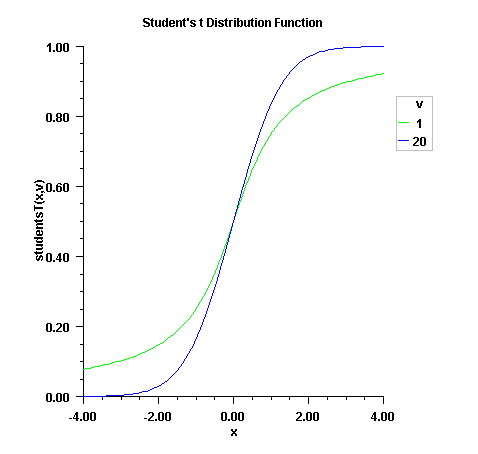Evaluates the Student's t cumulative probability distribution
function.
Namespace:
Imsl.StatAssembly: ImslCS (in ImslCS.dll) Version: 6.5.0.0
 Syntax
Syntax
| C# |
|---|
public static double StudentsT( double t, double df ) |
| Visual Basic (Declaration) |
|---|
Public Shared Function StudentsT ( _ t As Double, _ df As Double _ ) As Double |
| Visual C++ |
|---|
public: static double StudentsT( double t, double df ) |
Parameters
- t
- Type: System..::.Double
A double scalar value representing the argument at which the function is to be evaluated.
- df
- Type: System..::.Double
A double scalar value representing the number of degrees of freedom. This must be at least one.
Return Value
A double scalar value representing the probability that a Student's t random variable takes a value less than or equal to t. Remarks
Remarks
Method Cdf.StudentsT evaluates the distribution function of a
Student's t random variable with df
degrees of freedom. If the square of t is
greater than or equal to df, the relationship of
a t to an f random variable (and
subsequently, to a beta random variable) is exploited, and routine
Cdf.Beta is used. Otherwise, the method described by Hill (1970)
is used. If df is not an integer, if
df is greater than 19, or if
df is greater than 200, a Cornish-Fisher
expansion is used to evaluate the distribution function. If
df is less than 20 and  is less than 2.0, a trigonometric series (see
Abramowitz and Stegun 1964, equations 26.7.3 and 26.7.4, with some
rearrangement) is used. For the remaining cases, a series given by
Hill (1970) that converges well for large values of
t is used.
is less than 2.0, a trigonometric series (see
Abramowitz and Stegun 1964, equations 26.7.3 and 26.7.4, with some
rearrangement) is used. For the remaining cases, a series given by
Hill (1970) that converges well for large values of
t is used.
For greater right tail accuracy, see Cdf.ComplementaryStudentsT.
